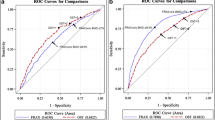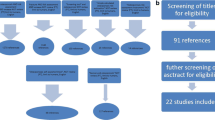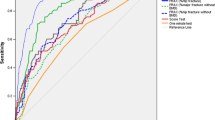Abstract
Osteoporosis in men is a largely neglected condition in Asia (and elsewhere), despite the fact that one-third of hip fractures occur in men. Moreover, access to bone mineral density (BMD) measurements is limited in many areas of Asia, and inexpensive methods of targeting high risk patients for BMD measurements would be valuable. We have developed a simple clinical assessment tool to identify high risk Asian men for BMD measurements. Information on risk factors was collected from 420 community-dwelling adult Chinese men aged 50 years and above using a structured questionnaire, and the ability of these risk factors to identify subjects with femoral neck BMD T score ≤ −2.5 was assessed. Multiple regression analysis and item reduction yielded a final clinical risk assessment tool based on only age and weight, similar to the Osteoporosis Self-assessment Tool for Asians (OSTA), described previously for Asian women. The OSTA values of ≤ −1 had a sensitivity of 81% and specificity of 66%, and the area under the receiver operating characteristics curve was 0.83. The index was validated in another sample of 356 men with a sensitivity of 82% and specificity of 67 %, and an AUC of 0.85. The usefulness of OSTA was further compared to calcaneal quantitative bone ultrasound (QUS) in the validation sample of 356 men. The optimal cutoff T score of −1.2 for QUS yielded sensitivity and specificity values of 75 and 67%, respectively. The AUC for QUS was 0.79. Combining OSTA and QUI gave a sensitivity of 88% and specificity of 66% to identify men with low BMD at the femoral neck, and an AUC of 0.86 which was statistically not different from either OSTA or QUI alone. We conclude that OSTA is a simple and effective clinical risk assessment tool for identifying not only female but also male subjects at increased risk of osteoporosis, and its use could facilitate the appropriate and more cost-effective use of bone densitometry in developing countries.
Similar content being viewed by others
References
Koh LKH, Ben Sedrine W, Torralba TP et al. (2001) A simple tool to identify Asian women at increased risk of osteoporosis. Osteoporosis Int 12:699–705
Kung AWC, Ho AYY, Sedrine WB, Reginster JY, Ross PD (2003) Comparison of a simple clinical risk index and quantitative bone ultrasound for identifying women at increased risk of osteoporosis. Osteoporos Int 14:716–721
Park HM, Sedrine WB, Reginster JY, Ross PD (2003) Korean experience with the OSTA risk index for osteoporosis: a validation study. J Clin Densitom 6:247–250
Yang NP, Lin T, Wang CS, Chou P (2004) Correlation of osteoporosis screening by quantitative ultrasound of calcaneus and Osteoporosis Self-Assessment Tool for Asians in Taiwanese. J Formos Med Assoc 103:130–136
Geusens P, Hochberg MC, van der Voort DJM et al. (2002) Performance of risk indices for identifying low bone density in postmenopausal women. Mayo Clin Proc 77:629–637
Richy F, Gourlay M, Ross PD et al. (2004) Validation and comparative evaluation of the Osteoporosis Self-Assessment (OST) in a Caucasian population from Belgium. Q J Med 97:39–46
Cadarette SM, McIsaac WJ, Hawker GA et al. (2004) The validity of decision rules for selecting women with primary osteoporosis for bone mineral density testing. Osteoporos Int 15:361–366
Center JR, Nguyen TV, Schneider D, Sambrook PN, Eisman JA (1999) Mortality after all major types of osteoporotic fracture in men and women: an observational study. Lancet 353:878–882
Kanis JA (2002) Diagnosis of osteoporosis and assessment of fracture risk. Lancet 359:1292–1236
Cheung EYN, Ho AYY, Lam E, Kung AWC (2004) Hormonal and lifestyle risk factors for low bone mineral density in Chinese men. Second Asia International Osteoporosis Foundation Conference. Abstract P05
Mei J, Yeung SSC, Kung AWC (2001) High dietary phytoestrogen intake is associated with higher bone mineral density in postmenopausal but not premenopausal women. J Clin Endocrin Metab 86:5217–5221
Kung AWC, Tang GWK, Luk KDK, Chu LW (1999) Evaluation of a new caleaneal quantitative ultrasound system and determination of normative ultrasound values in southern Chinese women. Osteoporos Int 9:312–317
Byrt T, Bishop J, Carlin JB, Byrt Bias (1993) prevalence and kappa. J Clin Epidemiol 46:423–429
Hochberg MC, Tracy JK, van der Klift M, Pols H (2002) Validation of a risk index to identify men with an increased likelihood of osteoporosis [Abstract]. J Bone Miner Res 17 (Suppl 1):S231
Adler RA, Tran MT, Petkov VI (2003) Performance of the osteoporosis self-assessment screening tool for osteoporosis in American men. Mayo Clin Proc 78:723–727
Koh LKH, Thoo FL (2001) Applying a simple clinical tool which identifies osteoporosis in Asian women to a cohort of Singapore Men [Abstract]. J Bone Miner Res 16 (Suppl 1):S394
Woo J, Li M, Lau E (2001) Population bone mineral density measurements for Chinese women and men in Hong Kong. Osteoporos Int 12:289–295
Hans D, Dargent-Molina P, Schott AM et al. (1996) Ultrasonographic heel measurements to predict hip fracture in elderly women: the EPIDOS prospective study. Lancet 348:511–514
Bauer DC, Gluer CC, Cauley JA et al. (1997) Broadband ultrasound attenuation predicts fractures strongly and independently of densitometry in older women. A prospective study. Study of Osteoporotic Fractures Research Group. Arch Intern Med 157:629–634
Miller PD, Siris ES, Barrett Connor E et al. (2002) Prediction of fracture risk in postmenopausal women with periphery bone densitometry: evidence from the National Osteoporosis Risk Assessment. J Bone Miner Res 17:2220–2230
Kung AWC, Luk KDK, Chu LW, Tang GWK (1999) Quantitative ultrasound and symptomatic vertebral fracture risk in Chinese women. Osteoporosis Int 10:456–461
Khaw KT, Reeve J, Luben R et al. (2004) Prediction of total and hip fracture risk in men and women by quantitative ultrasound of the calcaneus: EPIC-Norfolk prospective population study. Lancet 363:197–202
Welch A, Camus J, Dalzell N et al (2004) Broadband ultrasound alternation (BUA) of the heel bone and its correlates in men and women in the EPIC-Norfolk cohort: a cross-sectional population-based study. Osteoporos Int 15:217–225
Kanis JA, Gluer CC (2000) An update in the diagnosis and assessment of osteoporosis with densitometry. Committee of Scientific Advisors, International Osteoporosis Foundation. Osteoporos Int 11:192–202
Sen SS, Geling O, Messina OD et al. (2002) Comparison of body weight and body mass index as predictors for osteoporosis among postmenopausal Latin American women. Osteoporos Int 13 (Suppl 3):S27
Acknowledgements. The authors thank the nursing and technical staff of the Osteoporosis Center, Department of Medicine, Queen Mary Hospital for their assistance in carrying out this project, S. Yeung for analyzing the data, and G. Chu and C. Russo for assistance in preparing the manuscript. This study was supported by the Osteoporosis and Endocrine Research Fund, The University of Hong Kong.
Author information
Authors and Affiliations
Corresponding author
Rights and permissions
About this article
Cite this article
Kung, A.W.C., Ho, A.Y.Y., Ross, P.D. et al. Development of a clinical assessment tool in identifying Asian men with low bone mineral density and comparison of its usefulness to quantitative bone ultrasound. Osteoporos Int 16, 849–855 (2005). https://doi.org/10.1007/s00198-004-1778-z
Received:
Accepted:
Published:
Issue Date:
DOI: https://doi.org/10.1007/s00198-004-1778-z




